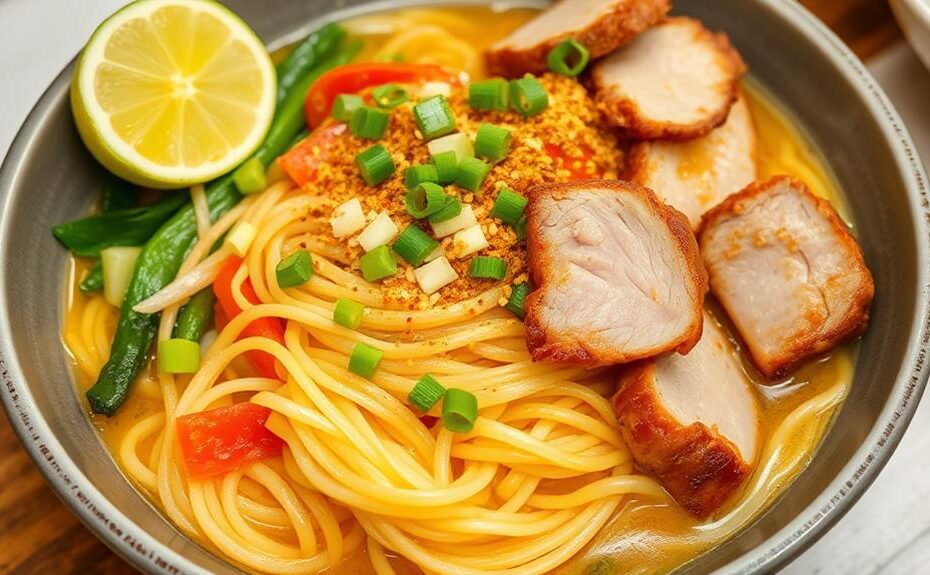Selecting the right noodles is crucial for perfecting Palabok. Start with bihon noodles, which are specifically designed for this dish. To achieve even softening, soak the noodles for at least 30 minutes before boiling them.
Boiling time is key to achieving the right texture. Boil the noodles for 10-15 minutes, aiming for an al dente texture. To make them easier to handle, consider cutting them in half after boiling.
Using shrimp stock instead of plain water enhances the flavor. This adds a richer, more savory taste to the dish. To create the signature sauce, combine shrimp stock and pork broth, and add annatto powder for the iconic yellow-orange color.
Sauteing aromatics is essential for flavor enhancement. Saute garlic and onion to bring out their natural oils and aromas.
Finally, adjust the seasoning with fish sauce to balance the flavors.
By following these steps, you'll be well on your way to perfecting Palabok noodles and unlocking a world of flavors and possibilities.
Understanding Pancit Palabok Basics
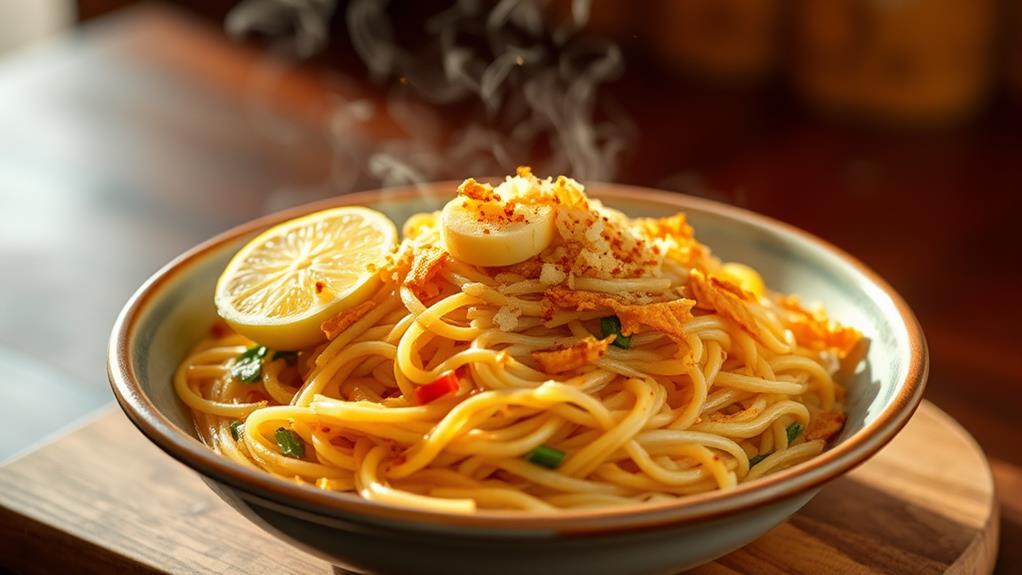
Understanding Pancit Palabok Basics
Selecting the Right Noodles
To make Pancit Palabok, you need to start with the right noodles. Bihon noodles are specifically designed for this traditional Filipino dish. These thin rice noodles require soaking until softened, then boiling for 10-15 minutes to achieve the perfect texture, which is neither too mushy nor too crunchy.
Creating the Signature Sauce
The rich, thick yellow-orange sauce is a crucial component of Pancit Palabok. This flavorful sauce is made with shrimp and pork stock, which can be enhanced with annatto powder to achieve the signature color.
Preparing Toppings
To add flavor and texture to your Pancit Palabok, prepare the necessary toppings. Common additions include shrimp, hard-boiled eggs, and crushed chicharrón. These toppings will elevate the dish and provide a well-rounded flavor profile.
Essential Ingredients and Sauce Preparation
Pancit Palabok's Essential Ingredients
Bihon noodles are a crucial component of traditional Pancit Palabok, as they absorb flavors well and provide the desired texture.
To ensure even softening and prevent mushiness, soak the noodles in water for at least 30 minutes before cooking.
Sauce Preparation for a Rich, Flavorful Base
To create a rich, flavorful base for your Pancit Palabok sauce, combine shrimp stock and pork broth for a savory seafood flavor.
Add annatto powder or annatto water to give the sauce its signature yellow-orange color and a slight earthy flavor.
To add depth, sauté garlic and onion before adding the meat and sauce ingredients, allowing the aromatics to infuse into the dish.
Variations of Filipino Noodle Dishes
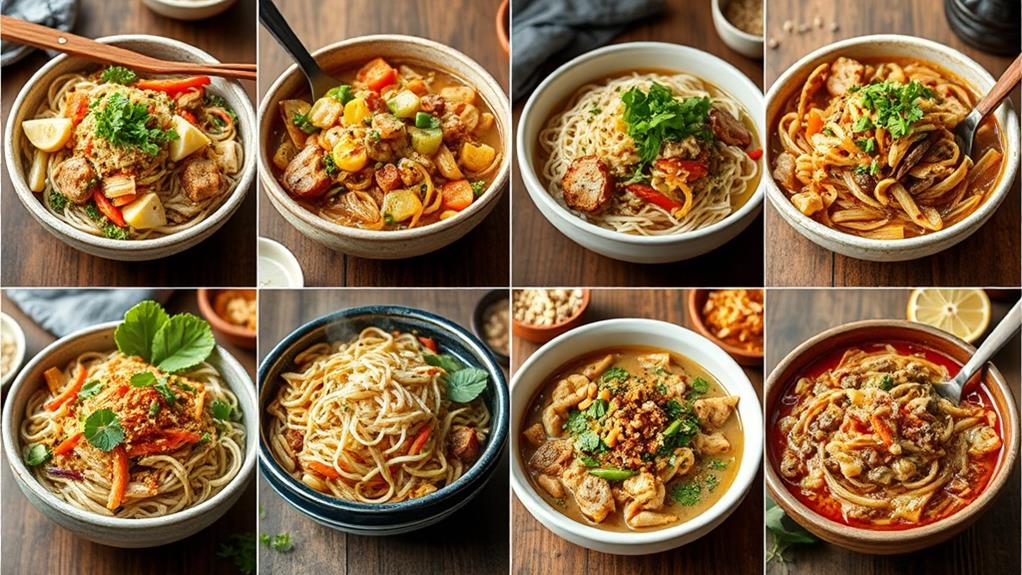
Variations of Filipino Noodle Dishes
Filipino noodle dishes offer a diverse array of variations, each putting its own twist on the traditional Pancit Palabok.
Pancit Luglug is a notable variation that features thicker cornstarch noodles, which are typically immersed in boiling water for preparation. This differs from the bihon noodles used in Pancit Palabok.
Another popular option is Pancit Malabon, which utilizes thick, tubular rice noodles and is often loaded with seafood options like shrimp, providing a heartier alternative to the traditional Palabok.
For a plant-based option, Vegetarian Pancit Bihon is a great choice, replacing meat with a mix of vegetables while still using bihon noodles for authenticity.
Pancit Canton offers a stir-fried noodle dish that employs wheat noodles and includes an assortment of proteins and vegetables, showcasing a different texture and flavor profile compared to Palabok.
Lastly, Sotanghon Guisado features glass noodles and is typically cooked in a light broth, providing a unique take on the traditional pancit experience with its distinct noodle type.
Key Cooking Techniques and Tips
Perfecting Pancit Palabok: Key Cooking Techniques
To achieve tender and flavorful Palabok, soak the thin rice noodles in water for at least 30 minutes before cooking. This step is crucial to prevent the noodles from becoming mushy during boiling.
When boiling, cook the noodles for 10-15 minutes, stirring occasionally, until they're al dente. Be mindful of the cooking time, as overcooking can lead to a sticky texture.
Tips for Easier Handling and Enhanced Flavor
Consider cutting the soaked noodles in half before cooking to make them easier to handle and eat when served.
To elevate the overall taste of your Pancit Palabok, cook the noodles in shrimp stock or broth instead of plain water. This will enhance the flavor of your dish.
Customizing Toppings and Recipe Adaptations
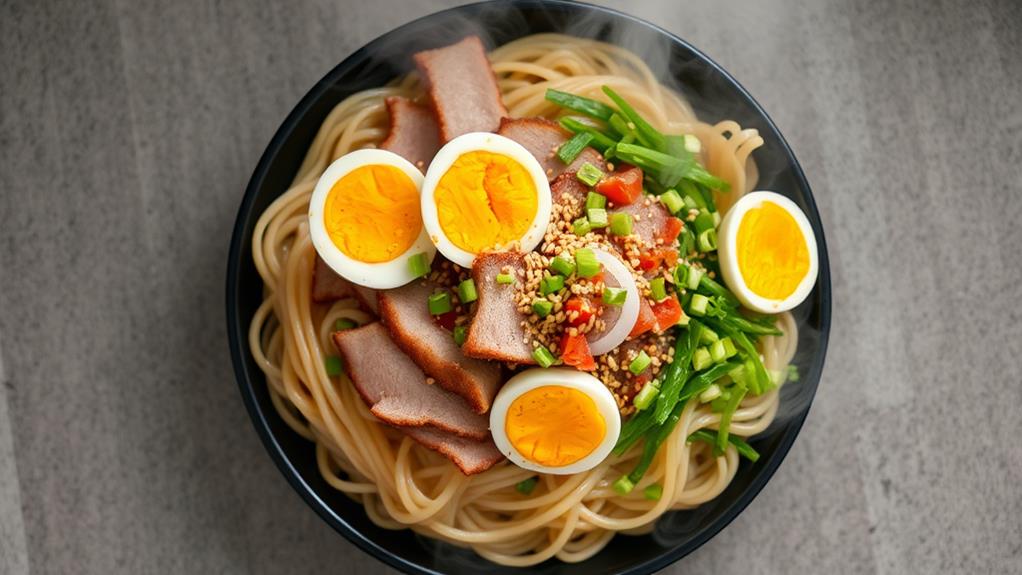
Customizing Pancit Palabok to Your Taste
Experiment with Toppings and Proteins
When customizing your Pancit Palabok, you can add protein-packed boiled eggs or savory shrimp to enhance flavor and texture.
Alternatively, substitute ground pork with vegetable broth and add veggies like bok choy or carrots for a vegetarian twist.
You can also experiment with different proteins like leftover chicken or dried shrimp to enhance the shrimp flavor without straying from the dish's authenticity.
Choosing the Right Broth and Sauce Consistency
When selecting a broth, consider the flavor profile you're aiming for.
For a seafood-inspired dish, use seafood stock as your base.
For a lighter flavor, opt for vegetable or chicken broth.
To adjust the sauce consistency, vary the amount of flour or cornstarch used.
Garnishing and Presentation
Achieving Perfect Noodle Texture
Achieving Perfect Noodle Texture
Soaking Noodles: Soaking bihon noodles in water for at least 30 minutes prior to cooking ensures they absorb moisture and soften evenly. This step is crucial for achieving the perfect noodle texture.
Cooking Noodles: Boil water in a pot and add the soaked noodles. Cook them for 10-15 minutes until they're just tender but still firm to the bite (al dente).
Be careful not to overcook them, as they can become mushy. Monitor the cooking time closely and follow package instructions for best results.
Post-Cooking Process: After cooking, drain the noodles and rinse them briefly under cold water to stop the cooking process, which helps maintain their texture.
Cutting the soaked noodles in half before cooking can make them easier to mix and serve with the sauce.
Balancing Flavors and Seasoning
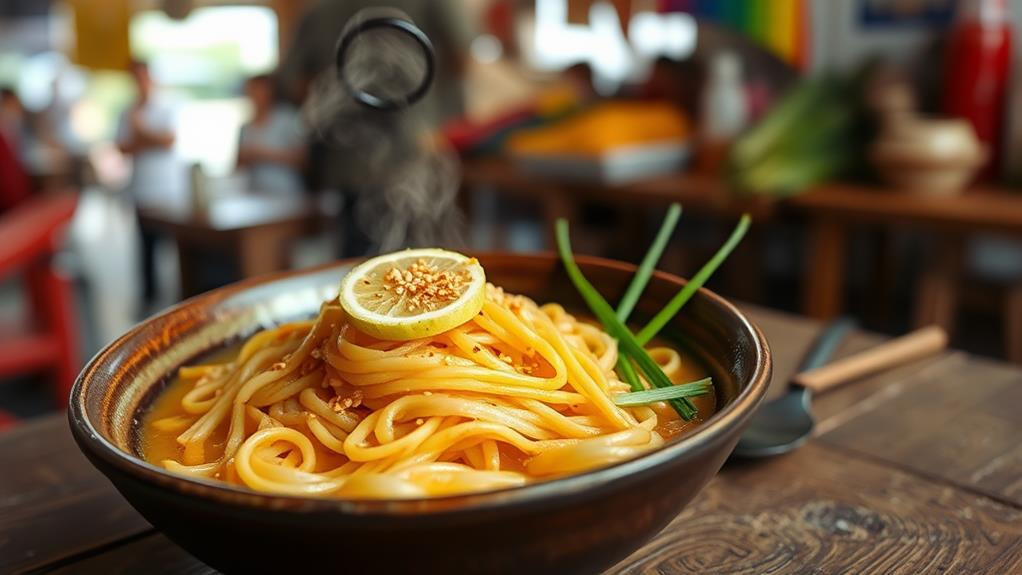
Building a Rich Flavor Profile
To create a harmonious flavor profile for Palabok, combine shrimp stock and pork broth as the foundation. This blend enhances the overall taste, providing a depth of flavor that's hard to achieve with just one or the other.
Achieving the Right Color
Start with a small amount of annatto powder to achieve the desired marigold color.
Gradually adjust the amount to avoid overwhelming the dish.
Balancing Flavors
Use fish sauce (patis) to season the sauce, providing a necessary umami kick and balancing the flavors of the rich broth.
Taste the sauce frequently during cooking and make adjustments with salt, garlic powder, or additional fish sauce to fine-tune the flavor profile to your preference.
Simplifying the Cooking Process
Streamlining the Cooking Process
To ensure your Palabok noodles cook evenly and maintain their texture, soak bihon noodles in water for at least 30 minutes before boiling.
When boiling, use a large pot of water and stir occasionally to prevent clumping. Cook the noodles for 10-15 minutes, checking for doneness to avoid overcooking.
To maximize your time, prepare the sauce separately while the noodles cook. Consider using pre-made shrimp stock or broth to simplify flavor enhancement and save time on making stock from scratch. This will still give you a rich and satisfying taste.
Once the noodles are cooked, store them in an airtight container to maintain their texture. Do the same with the sauce, so you can easily reheat and serve when you're ready.
Exploring Regional and Cultural Influences
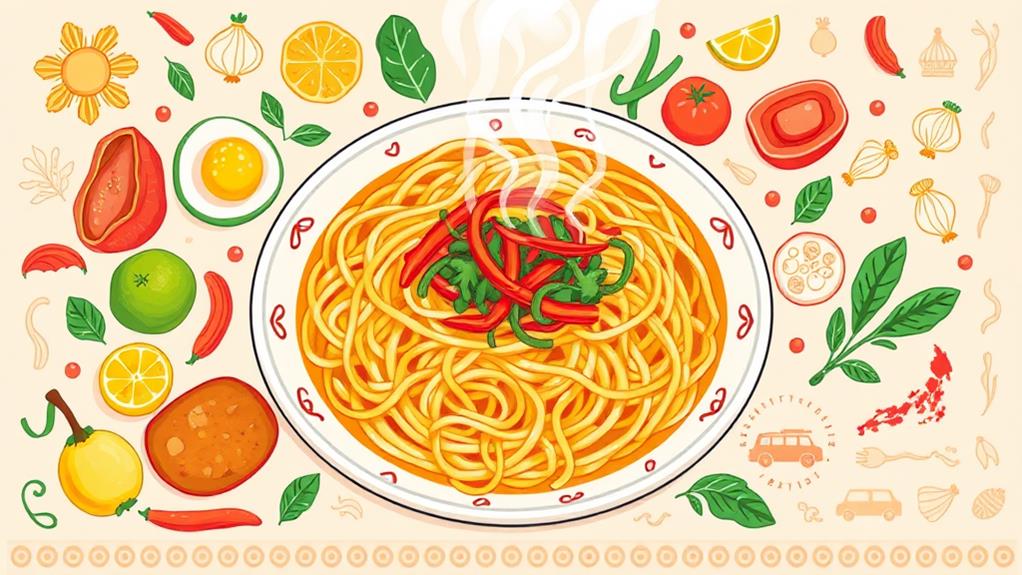
Pancit Palabok: A Dish with Deep Cultural Roots
Pancit Palabok, a beloved Filipino dish, has a rich cultural heritage that extends beyond the Philippines.
Its development was influenced by Chinese noodle dishes introduced by migrants. This cultural fusion is a testament to the integration of diverse culinary traditions in the Philippines.
Regional Variations Showcase Unique Culinary Practices
Pancit Palabok has regional variations, such as Pancit Malabon and Pancit Luglug, which incorporate local ingredients and preparation methods.
These variations showcase the unique culinary practices of different Filipino provinces.
Traditional Garnishes Hold Cultural Significance
Traditional garnishes like chicharrón and tinapa not only enhance the flavor profile but also signify the cultural importance of using local and preserved ingredients in Filipino cuisine.
Pancit Palabok: A Symbol of Hospitality and Togetherness
Pancit Palabok is a popular dish during celebrations and family gatherings.
Its popularity underscores its role in Filipino culture as a symbol of hospitality, togetherness, and the celebration of culinary heritage.
Can the Key Ingredients for Pancit Rice Noodles also be used for Perfecting Palabok Noodles?
Yes, the perfect pancit rice noodles ingredients can also be used for perfecting Palabok noodles. Both dishes share similar key ingredients such as rice noodles, annatto powder, fish sauce, and shrimp. By using these same essential elements, you can achieve a delicious and authentic Palabok noodle dish.
Nutritional Information and Serving Suggestions
Pancit Palabok's Nutritional Profile
A serving of Pancit Palabok contains approximately 405 calories, providing a balanced mix of carbohydrates, protein, and fat.
However, it's essential to be aware of the high sodium content, which accounts for 75% of the daily value per serving.
Optimizing Your Palabok Experience
To make the most of your meal, consider serving sizes of around 6g.
Pairing your Palabok with fresh calamansi or lime adds a burst of flavor and Vitamin C.
Adding toppings like hard-boiled eggs, crushed chicharrón, and scallions not only enhances flavor and texture but also adds protein and essential vitamins.
These toppings also contribute to dietary fiber, supporting digestive health and overall well-being.
Frequently Asked Questions
What Is Palabok Sauce Made Of?
Palabok sauce is a combination of several key ingredients.
The base of the sauce is made by combining shrimp stock and pork broth, which provides a rich and savory flavor.
To thicken the sauce, a cornstarch slurry is added. Annatto paste is also included to give the sauce its signature yellow-orange color.
To add depth to the sauce, ground pork is sautéed with garlic and onions.
Additionally, fish sauce is used to add saltiness and tinapa is used to add umami flavor.
What Is the Difference Between Palabok and Luglug?
Palabok and luglug are two distinct Filipino noodle dishes. While they share some similarities, their differences lie in their ingredients, preparation, and serving styles.
Palabok uses thin rice noodles, whereas luglug features thicker cornstarch noodles. This variation in noodles gives each dish a unique texture and flavor profile.
When it comes to serving, palabok is typically garnished with chicharrón and eggs, adding a crunchy and savory element to the dish.
Additionally, the sauce is poured over the noodles just before serving, which helps to preserve the noodles' texture and prevent them from becoming soggy.
What Is the Difference Between Malabon and Palabok?
Malabon noodles are thicker and tubular, whereas Palabok noodles are thin and bihon. This difference in noodle texture sets the two dishes apart.
Malabon's sauce is richer and seafood-based, while Palabok's is shrimp and pork-based. The distinct flavors of the sauces are a result of the different ingredients used in each.
Malabon is associated with Malabon City, while Palabok is popular throughout the Philippines. These regional variations contribute to the unique characteristics of each dish.
Does Palabok Spoil Easily?
Palabok spoils easily. To maintain freshness, it's essential to store it properly.
Keep it in an airtight container in the fridge. This will help prevent spoilage and keep it fresh for a longer period.
If you notice any of the following signs, it's time to discard the palabok: off smells, discoloration, or mold.
Typically, leftovers can be consumed within 3 to 4 days before they go bad.
For longer storage, freeze it for up to 2 months. However, it's recommended to separate the noodles and sauce before freezing to maintain better texture later.
When reheating, make sure to heat it to 165°F (74°C) to ensure food safety.
